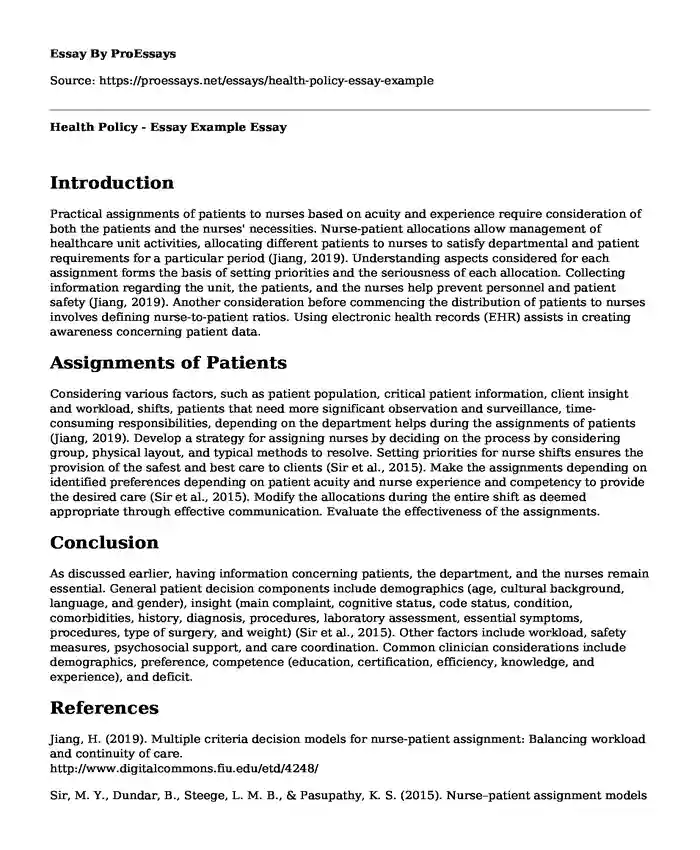Introduction
Practical assignments of patients to nurses based on acuity and experience require consideration of both the patients and the nurses' necessities. Nurse-patient allocations allow management of healthcare unit activities, allocating different patients to nurses to satisfy departmental and patient requirements for a particular period (Jiang, 2019). Understanding aspects considered for each assignment forms the basis of setting priorities and the seriousness of each allocation. Collecting information regarding the unit, the patients, and the nurses help prevent personnel and patient safety (Jiang, 2019). Another consideration before commencing the distribution of patients to nurses involves defining nurse-to-patient ratios. Using electronic health records (EHR) assists in creating awareness concerning patient data.
Assignments of Patients
Considering various factors, such as patient population, critical patient information, client insight and workload, shifts, patients that need more significant observation and surveillance, time-consuming responsibilities, depending on the department helps during the assignments of patients (Jiang, 2019). Develop a strategy for assigning nurses by deciding on the process by considering group, physical layout, and typical methods to resolve. Setting priorities for nurse shifts ensures the provision of the safest and best care to clients (Sir et al., 2015). Make the assignments depending on identified preferences depending on patient acuity and nurse experience and competency to provide the desired care (Sir et al., 2015). Modify the allocations during the entire shift as deemed appropriate through effective communication. Evaluate the effectiveness of the assignments.
Conclusion
As discussed earlier, having information concerning patients, the department, and the nurses remain essential. General patient decision components include demographics (age, cultural background, language, and gender), insight (main complaint, cognitive status, code status, condition, comorbidities, history, diagnosis, procedures, laboratory assessment, essential symptoms, procedures, type of surgery, and weight) (Sir et al., 2015). Other factors include workload, safety measures, psychosocial support, and care coordination. Common clinician considerations include demographics, preference, competence (education, certification, efficiency, knowledge, and experience), and deficit.
References
Jiang, H. (2019). Multiple criteria decision models for nurse-patient assignment: Balancing workload and continuity of care.
http://www.digitalcommons.fiu.edu/etd/4248/
Sir, M. Y., Dundar, B., Steege, L. M. B., & Pasupathy, K. S. (2015). Nurse–patient assignment models considering patient acuity metrics and nurses’ perceived workload. Journal of Biomedical Informatics, 55, 237-248. http://www.sciencedirect.com/science/article/pii/S1532046415000726.
Cite this page
Health Policy - Essay Example. (2024, Jan 11). Retrieved from https://proessays.net/essays/health-policy-essay-example
If you are the original author of this essay and no longer wish to have it published on the ProEssays website, please click below to request its removal:
- Annotated Bibliography Example on Autism Spectrum Disorder
- Nursing Philosophy Paper Example
- Managed Care: A Comprehensive Care Technique for Quality Healthcare
- Diabetes Type II: The Chronic Disease Affecting Glucose Metabolism - Research Paper
- Scientific Rigor: A Value in Nursing for Evidence-Based Thinking - Essay Sample
- Risk of Bone Diseases Increases With Age: Osteoporosis & Fracture Risk - Essay Sample
- Essay Example on Overweight Predisposes Individuals to Cardiovascular Diseases: BMI Vital for Interventions







